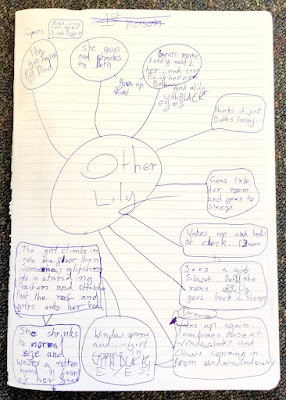Brainstorming , Balance and Bright Ideas
Returning to a class of year 2 learners after an absence of two weeks, I began by asking them if they were able to remember what we had focused on during our previous session together. They thought for a moment and then began to recall some of the writing ideas we had previously examined. I was most impressed when they mentioned that we had been looking at the ways in which writers gather ideas. It was then a student seated at the back of the group raised his hand enthusiastically looked me directly in the eye and told me,
'We did lots of brain-draining.'
'Close,' I said. 'I think you mean brainstorming, although sometimes it does feel a little draining.'
Ah yes, from the innocent we often get refreshing honesty and accuracy.
Now that there prior knowledge had been activated, it was time to move into the new workshop. This time we were looking at the craft strategy of ‘inside/outside’ (physical world/emotional world) The teachers and I had noticed that much of their writing of personal narratives concerned itself with the physical or outer world. Students were basically writing recounts of events that were list like in structure. I modelled an example from my own writing where I wrote about my fear when as a small boy I was asked to collect eggs from my grandfather’s chook pen (chicken coop) and my concerns about his feral rooster. In my writing I tried to achieve some balance between the physical world (chickens, rooster, collecting eggs, enclosure etc) and the inner or emotional world ( the sense of fear that manifest itself in my increased heartbeat, sweaty palms, wobbly legs.) I shared an extract from Roald Dahl’s The Witches where Dahl small boy narrator, describes the inner fear he suffers when he is faced with the prospect of being discovered by the witches as they gather for a meeting.
I then invited the students to practice this strategy for themselves in their independent writing. These previously inhibited or ‘safe’ writers then produced some wonderful examples of writing that clearly showed they understood how to apply ‘inside/outside’ to their writing. They wrote about their fear of attempting things for the first time.
They wrote about fear of the dark. One student wrote about the fear and trepidation he felt when his mother suffered breathing difficulties and he had to call for an ambulance. Another student wrote about her fear of going to the opposite end of the house on her own. Their writing was refreshingly honest and emotionally charged. There was a greater tension and clarity to the writing.
In tying up the threads of the lesson, I asked the children what they had discovered about writing from the lesson. One boy replied, 'I have learnt that it is important to have a balance between the inside and outside world in your writing. It makes your writing more interesting to read.'
In debriefing with the teacher of this class, she was suitably impressed with the way their writing had been elevated in quality by the use of this strategy.
We had started out with brain-draining and ended up with something quite the opposite. As Bill Martin once said, 'feeling smart about something is energizing.'








Comments
Post a Comment